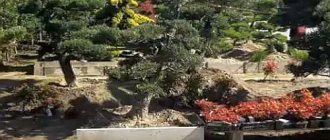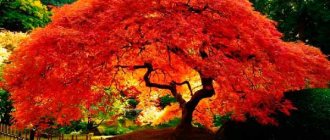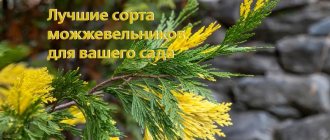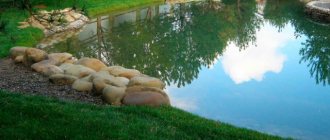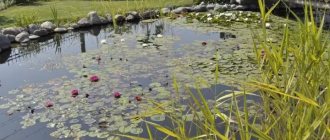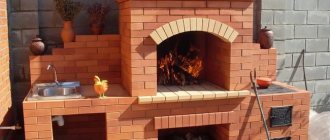A garden of stones and plants or a rock garden today decorates many areas. And one of its most common varieties is the alpine slide. In fact, it is a mountain landscape artificially created in a limited area. Plants for an alpine hill are selected specifically to decorate and enliven, but not overshadow the stone composition.
- Which plants are suitable
- Rules for selecting plants
- Flowers
- Shrubs
- Ground cover
- Herbs
- Conifers
- Plant arrangement diagram
What it is?
Alpine slide is a composition in landscape design that demonstrates a piece of the mountain landscape.
Alpine slides consist of stones and flowers and can be supplemented with shrubs, garden decorative elements, even waterfalls. There is another type of similar decoration in the landscape - rockery. But unlike a slide, it is flat. Creating a rock garden requires elevation and descent - that's why it is called a slide.
In the photo there is a rock garden on the site
Arched gazebo made of roses
To create an arched gazebo, you need to place 2 arches so that they are connected at the highest point, and the legs of the arches are equidistant from each other. Bushes of climbing or ground cover roses with flexible long shoots are planted densely along three sides of the future gazebo. The fourth side of the arch will be the entrance to the gazebo. You can put a bench in the gazebo. I assure you, this will become the most romantic place in your garden.
Where is the best location on the site?
Most often, an alpine slide in a dacha is moved to the edge of the site or moved to a corner, installed near the fence: when choosing this option, make sure that the main slope is oriented to the south. This way, plants located on a stone hill will always have enough sun.
Check out our selection of climbing plants for a fence.
In the photo there is a stone slide near the fence
The second option is near the path. A towering alpine flowerbed effectively emphasizes the landscape and sets the dynamics of the garden area.
Option number 3 - in the center of the site. Suitable for those who focus on decor and prefer to sow the garden space with lawn grass. A high alpine hill surrounded by a flat lawn looks original and attracts attention. It will definitely become the main accent of the landscape.
The last option is no less interesting than the previous ones: if you still have a free area or an unused corner near the house, plant a rock garden in this place.
Important! In a small area, designers do not recommend central placement: to save space, an alpine slide can be placed near a fence, against the wall of a building, or in a corner of the area.
Creating a rose garden
The most win-win and effective option is to dedicate your garden only to roses. You can bet on roses of one color or variety, or you can create colored fireworks. A garden containing hybrid teas, floribundas and ground covers will look very stylish; or miniature, ground cover and climbing. There are a lot of options here.
We can say with full confidence that your garden will become a real designer’s find, where you can get creative with differences in heights, horizontal and vertical, different shapes and textures.
What can you decorate with?
Let's start with the fact that the slides themselves, as a rule, look very attractive. But if just stones and plants are not enough for you, you can resort to brighter accent solutions.
Light stones or sand
Snow-white pebbles or broken marble chips, as well as light sand, are ideal for laying around the perimeter or filling voids in the composition. On a sunny day, they will literally glow in the sun, attracting attention. And even in a cloudy background, such a background is pleasing to the eye; an alpine flowerbed in a white robe looks more elegant.
Garden figurines
When purchasing ready-made decorations, you need to consider the style or direction of the slide design. For example, in the classical style, plaster statues are combined with light marble chips. Country style is characterized by wooden elements.
Thanks to the figures, they recreate entire scenes from their favorite fairy tales or cartoons.
In the photo there are garden figurines made of wood
Tree
In terms of naturalness, wood has no equal: it easily fits into the desired plot or design of the slide. Use slabs, saw cuts, hemp, logs, and branches for decoration.
Water
Rock gardens and ponds are like two halves of one whole. You can make a shallow pond at the base of the slide or lay out tiers for a waterfall in the slide itself. In the second case, be sure to take care of drainage so that the roots of the plants do not rot due to constant contact with water.
Advice! If you are afraid to create a real waterfall, start with a dry stream: an imitation is made from stones or plants.
Selection of flowers for the rock garden
In order for the alpine slide to be a success, it is very important not to make a mistake in choosing plants and planting them correctly. Of course, a lot will depend on your taste and imagination, but there are some general rules for selecting plants for an alpine hill that are very important to follow.
Plants should be fairly unpretentious and suitable for your climatic conditions. Preference should be given to short and compact species. The smaller your rock garden, the more miniature plants should decorate it. Plant plants that get along well with each other and have similar requirements for growing conditions.
Avoid fast-growing species, they will oppress neighboring plants. When planting, consider the light and humidity requirements of your green friends. It is very important that the alpine slide maintains its decorative appearance throughout the year. To do this, it is necessary to take into account the life cycle of various plants and the timing of their flowering.
Naturally, low-growing and ground cover plants look good on the rocky crust; they will not cover the stones or interfere with each other. In nature, on rocky peaks you can find a large assortment of creeping ground cover plants that are hardy and at the same time beautiful. Alpine plants and flowers beautifully frame stones on a hill, fill all the voids and do not require much attention when caring.
Flowers for an alpine slide
An alpine hill is a complex flower garden, and it is created for many years, so the basis of the composition should be perennial plants. Their choice is so wide that you can overdo it with excess and diversity of flowers, violating the concept of a rock garden. To do this, do not be lazy to draw a diagram indicating the flowering dates of the plants you have chosen. Work on this once, and you will avoid mistakes and get a decent flower arrangement.
Perennial flowers for alpine hills
They form the basis of the rock garden. It is impossible to list everything. When choosing perennial flowers, do not forget that large varietal species (for example, gladioli, dahlias) will look out of place in a mountain landscape. Give preference to small, delicate ones that are associated with wild nature. Of course, true mountain plants are suitable for a rock garden: Armeria, blooming in rock crevices, Erinus alpinus and others. Thrift
Near large stones you can plant gorse, cereals and ferns. For example, aspelenium, millipede, bladderwrack and acanthedral. Cereals - fescue, evergreen oats, feather grass. You can use some types of wormwood, as they have very decorative and spicy-aromatic leaves of various shades. Decorative moss Dicranum and Hypnomoss will add naturalness to the rocky landscape.
Plants such as alpine and shrub aster, hyssop officinalis, low-growing bells, yarrow, dicentra, flax, aquilegia, decorative varieties of onions, angustifolia lavender, gentian, carnations, small petals, violets, oregano, forget-me-nots, St. John's wort and many would be appropriate for the rock garden. other.
And, of course, the “highlight” of your composition will be a truly alpine flower - edelweiss (Leontopodium). Its grayish-white felt baskets do not shine with bright beauty, but planted in groups, they create an extraordinary natural flavor of the mountainous area.
The most popular perennial for alpine hills is aubrieta (Aubrieta Adans). Cabbage cruciferous. Grows in the mountains of the Middle East and the Balkans. Another name is obriecia. It blooms in a pink, purple, blue or red dense carpet. After flowering, the shoots turn into a kind of withered moss. To avoid a sloppy appearance in rock gardens, the plant is cut off and thus forced to bloom again.
Arabis is one of the best plants for alpine slides. In summer, it prefers shade at midday. Planting is “bouquet”. Several cuttings are planted in one hole. White, crimson or carmine flowers bloom in May. A honey plant that attracts bees with its rich aroma. White varieties freeze slightly in winter, but quickly recover from the root. There are paniculate Arabis hybrids. Hybrid forms lose their characteristics when regenerated by seeds, so they are propagated by cuttings. Just like saxifrage, it actively displaces everything growing nearby, so Arabis layerings must be cut off. The new varieties have modified leaves: A. Ferdinanda - with gray-blue leaves with white edges; A. Proccurens “old gold” – with khaki striped leaves; A. Variegata – with jagged white edges. After flowering, the seed pods are removed. Seedlings begin to bloom after a year.
Annual flowers for alpine hills
Like a lifesaver, they will help you fill emerging voids (bald spots) and close fading bulbous ones. For example, large-flowered purslane, mesembryanthemum, marigolds, gazania, eschscholzia, ornamental grass haretail and others.
Bulbous plants for alpine hills
You should choose short and medium-sized ones. Muscari, crocuses, colchicums, scillas, snowdrops, chiodonoxas, iridodictiums, and poultry are appropriate there. Of the tulips, you should focus on botanical species such as Kaufmann tulips. All these bulbous flowers are delicate and beautiful, but they have a short decorative life; this must be taken into account when determining their place in the rock garden.
Ground cover plants for alpine hills
Very important for alpine slides. After all, they are the ones who decorate the stones and slopes. We will recommend some, from which you can choose the ones that suit your color scheme and flowering time.
Allisum - blooms in late spring, silvery slightly pubescent leaves combine beautifully with yellow and white flowers. Iberis - there are annual and perennial species. Forms beautiful “pillows” and fills the space well under tall perennials. Flowering time varies depending on the variety.
Arabis - there are many types of annual and perennial, all of them have a creeping stem. There are species with decorative leaves. Saxifraga - leaves and peduncles collected in a rosette form a dense small “cushion”, from which you can form a flowering carpet.
Aubrieta - forms mats densely strewn with flowers. Leaves with leaves in winter. Flowering is very long. The color of the flowers depends on the variety. Woodruff is a mountain flower, perfect for a rock garden. It can be annual or perennial. Grows well in rock cracks.
Veronica - its mountain ground cover species will decorate an alpine hill. Thyme - all its types are simply gorgeous plants for a rock garden. It has many advantages; it forms thick, fragrant mats with an abundance of small flowers. Bryozoan awl-shaped - forms green “pillows” similar to moss. Blooms profusely with small flowers all summer.
Soapwort - has species for planting in stone crevices, as well as ground cover. The flowers can be white or pale pink. Phlox subulate - forms beautiful flowering carpets and adds charm to rough stone blocks.
Tenacious - this cute plant grows well on rocky slopes, however, it can grow very large. White sedum will delight you with a white mat of fragrant small flowers. Juvenile - various types of this plant are very beautiful in group plantings against the backdrop of stone boulders.
Relatively large plants for alpine hills are represented by ornamental shrubs. The main problem associated with this type of plant is the fall of leaves in autumn, which creates difficulties in caring for the flower garden. Therefore, it is advisable to choose evergreen varieties. Barberries have very decorative foliage and berries; the winter-hardy variety “Nana” has boxleaf leaves, and the evergreen variety “Klugowski”.
Cotoneaster also has beautiful foliage and has many decorative species and varieties (shrub and creeping), including semi-evergreens - Dummera and multifloral.
Common heather is a low-growing evergreen shrub that will adequately decorate your rock garden. There are about 50 varieties, among which you can choose those that are suitable both in appearance and in terms of flowering time. For example, pink "Tib", white "Velvet Fascination", salmon "JHHamilton", purple "Dark Beauty", red "Mazurka", purple "Marllen" will bloom one after another, and some varieties also have decorative leaves ("Amilto ", "Jan Dehher", "Velvet Fascination"). Varieties also differ in height.
The familiar and beloved spirea also has species suitable for alpine hills - birch-leaved, Japanese, white-flowered, Bumalda, low, dwarf. Unfortunately, the last two species are rare.
It is also worth noting the shrubby cinquefoil. This bush grows up to 1 m, is very unpretentious, and blooms for a long time. These are creamy white “Gilford Cream”, yellow “Goldfinger”, lemon “Kobold”, pink “Pink Queen”, white “Abbotswood”, red “Red Robin”, orange “Hopley Orange” and many other different varieties.
Also used in rock gardens, but can freeze slightly, are boxwood, Japanese chaenomelis, and mahonia subleavia.
Scheme of planting plants in rock gardens
The choice of plants for an alpine hill is quite large; you can, of course, use ready-made planting schemes, but creative individuals will be very interested in our article today. Thanks to some tips, we will try to study and understand the features of growing future residents of the rock garden ourselves.
Planting a hill is carried out from top to bottom, and it is in this order that we propose to consider advice on choosing plants.
How to do it yourself?
Do-it-yourself Alpine slide is a reality. To recreate the mountain landscape on the site, the main thing is to strictly follow the instructions.
Step-by-step instruction
Selecting a location
Draw up a diagram of the site, indicating static structures and the location of the cardinal directions. For a slide you need a bright, free area of a suitable size - but the bigger the better.
Important! The creation of a rock garden begins in the fall - only by spring it will be ready for planting.
Preparation
Forming the height of the rock garden begins with drainage. First of all, the site needs to be leveled and compacted. Lay a mixture of sand and crushed stone on the ground, forming the top in the right place, the levels of the future structure. The drainage should also be compacted and covered with soil - the composition is selected for the plants that are planned to be planted.
Shrinkage
At this stage, nothing needs to be done - the “blank” is left until spring, until natural deformation occurs.
Working with stones
Start with the largest ones, sinking them into the ground by 35-50%. Small stones are placed next to large ones so that they do not slide down the hill during rains or melting snow. Form the desired composition, leaving room for greenery.
Landing
Plants are planted according to the same principle as stones: first large, then small. Tall shrubs are moved closer to the top, low creeping ones are located at the foot. Maintain symmetry - the entire width of the slope should be decorative.
After completion of the work, new residents need to be watered and the free soil mulched with bark or stones. This will make the composition complete and will help avoid the appearance of weeds and facilitate further care.
Video instructions for beginners
If you are going to decorate the alpine zone exclusively with coniferous plants, be sure to watch the video instruction “10 steps in creating an alpine zone from conifers”:
Landscaping of an alpine hill with conifers
No mountain landscape would be complete without dwarf coniferous shrubs. These can be creeping, cushion-shaped varieties of conifers such as:
- thuja (Danica, Little Dorrit, Hoseri);
- mountain pine (Mughus, Gnom, Mors, Winter gold);
- Norway spruce (Little Gem, Nidiformis, Will's Zwerg, Echiniformis);
- Canadian or gray spruce (Conica, Alberta Globe);
- junipers (Nana, Echiniformis, Green Carpet, Tamariscifolia, Blue Carpet, Blue Star);
- fir (Korean).
Dwarf coniferous shrubs diversify the flora of the alpine hill
For small alpine slides created with your own hands (photos of these can be seen in various sources), the height of the conifers should not exceed 0.5 - 0.7 m. If the area is large and the rock garden is extensive, then their height can reach one and a half meters. You can combine conifers to create contrast in color and shape. Another option is a smooth transition from one form to another. This creates a dynamic image. The same method can be applied to color dynamics.
Following the recommendations for the correct selection of substrate for conifers and planting time will ensure that these evergreen plants will decorate your corner of nature for a long time.
Korean fir looks impressive on an alpine hill
Care instructions
The process of caring for an alpine flower bed is quite simple; it can be roughly divided into seasons, each of which has a separate list of tasks:
- Spring. Remove covering material, repair damage, apply fertilizer. If necessary, plant annuals or bulbs.
- Summer. The main thing is to water regularly. In addition, remove weeds, clear the rock garden of fallen leaves and diseased plants, and trim the bushes.
- Autumn. Dig up bulbous plants, plant perennials, cover the plants for the winter.
- Winter. In winters with little snow, add snow yourself so that the slide retains its appearance.
Border of roses
Roses can be planted in the border along the path or recreation area, gazebo. You will get a kind of mini-fence. The height of this hedge will depend on which roses will be planted: ground cover or hybrid tea. Floribunda roses are good in the border. If there are not enough roses, they can be planted at large intervals. Then roses can be alternated with other decorative perennials, herbs, or bright annuals, such as evening primrose.
Beautiful design ideas for inspiration
Observation is a guarantee that you will be able to create a beautiful rock garden on your site. Just copy the ideas you like and recreate them.
For example, white stones do not have to be small - large boulders look no less elegant.
If the site already has a slope, take advantage of the natural landscape to create a slide.
Cobblestones can be not just large, but very large - as in the photo below. Flowers against their background look very contrasting.
An unusual option is to decorate with stones. You can use carved figures or just beautiful stones. It looks original if you put flat plates on the end.
And lastly, succulents. They do not require complex care and get along well on rocks and in poor soils. Stone roses and sedums can even overwinter in the garden, recovering beautifully with the arrival of warmer weather.
An alpine flowerbed is a spectacular decoration for a site. It’s not difficult to create - the main thing is not to be afraid to experiment!
Decorative design
Decor made from natural materials, artificial ponds, and lighting give the rock garden a unique look. The mountain landscape will be complemented by dry streams. With proper arrangement, it seems as if a stream of water has recently flowed along the dry riverbed. The source of the stream should come out from under a large block, the mouth should be hidden in green spaces and large leaves. The water surface is imitated with pebbles and fine gravel.
Alpine slide with pond
A pit is dug for the pond and the walls are insulated with butyl rubber film. A small pond can be made from a car tire or a special fiberglass liner, which is placed in a pit that follows the shape of the sides. For a stream flowing along a stone bed, a pump is installed in the pond and connected to a water supply hose. For the cascade, take flat stones, fasten them with polyurethane foam, and cover the seams with small fragments. A small fountain will decorate the rock garden and create coolness. To make work easier, buy a pump with a built-in filter. The unit is installed in a container, filled with water, and turned on according to the instructions. To create a fountain without a pump, a water pipe is led into a pond. Water can be diverted to the garden for irrigation.
Slide lighting
A rock garden illuminated by mini-spotlights or LED lamps on pegs looks impressive in the evening. Lamps with a wide scattering angle illuminate shrubs, while directional lamps illuminate flowers and foliage. The simplest lighting option is solar-powered lanterns. The absence of a cable gives freedom of action; lighting fixtures can be installed on each tier, illuminating a pond or terrace. Ground lamps can be used to outline the contour of a picturesque area or highlight shrubs. Underwater lighting with lamps of different colors visually increases the volume and colors the water. Floating solar-powered ball lamps move freely around the pond.
The lanterns will be replaced and the outline of the alpine slide will be illuminated by stones and pebbles coated with luminescent paint.
Setting up an area for reading or drinking tea
Behind a fragment of mountain nature there is a lawn for relaxation. For comfort, two sides are framed with a green wall of deciduous shrubs, low-growing varieties of cypress and thuja, which reach 80-90 cm. A platform with smooth contours, strewn with gravel or paved with the same material as the paths, is combined with the rock garden. The recreation area is equipped with rattan garden furniture. For the table, a slab (large slab) of rock is laid on a base of blocks. Original tables and benches are made from gabions and boards. Such options create a feeling of harmony and integrity. For reading by the pond, you can place a tray on the stones. A stone outdoor fireplace will warm and decorate the area.

